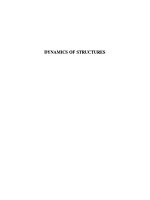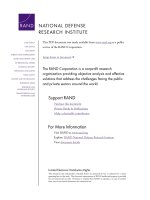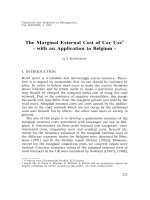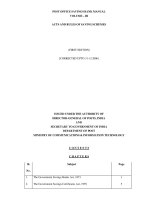- Trang chủ >>
- Khoa Học Tự Nhiên >>
- Vật lý
preparation of wo3 nanoparticles and application to no2 sensor
Bạn đang xem bản rút gọn của tài liệu. Xem và tải ngay bản đầy đủ của tài liệu tại đây (412.4 KB, 4 trang )
Preparation of WO
3
nanoparticles and application to NO
2
sensor
Dan Meng, Toshinari Yamazaki
*
, Yanbai Shen, Zhifu Liu, Toshio Kikuta
Faculty of Engineering, University of Toyama, 3190 Gofuku, Toyama 930-8555, Japan
1. Introduction
Nitrogen dioxide, NO
2
, is toxic and deteriorates the environ-
ment through acid rain, photochemical smog, and the production
of ozone [1]. Therefore, the development of an NO
2
gas sensor for
environmental monitoring has been expected. Other than to show
a high sensitivity, the NO
2
gas sensor is desired to operate at a low
temperature, if possible, at room temperature. This low operating
temperature is important for low electric power consumption and
long-term stability.
Numerous attempts have beenmade to use various metal-oxide
semiconductors as gas sensors [1–14]. Among these semiconduc-
tors, tungsten trioxide (WO
3
), an n-type semiconductor, is known
as a promising material for sensing NO
2
[1,5–13]. The NO
2
sensing
is due to the change in the resistance caused by the adsorption of
NO
2
on WO
3
surface and electron exchange between WO
3
and
adsorbed species. As the gas adsorption occurs at the surface, a
large surface-to-volume ratio of the WO
3
sensor is expected to lead
to a high sensitivity. Thus, many researchers have focused their
attention on a gas sensor made of WO
3
nanostructures accom-
panied with a large surface-to-volume ratio [7–11].
Various methods for preparing WO
3
for a sensing material, such
as magnetron sputtering [12], sol–gel [13], and gas evaporation
[14,15], have been extensively explored. Of these methods, the gas
evaporation is a method extensively studied by Kimoto et al. [16];
they evaporated various metals using resistive heating under inert
gases at a low pressure. Kaito et al. [17] applied this method to the
formation of metal-oxide nanoparticles, such as WO
3
, MoO
3
, etc.;
they evaporated various metals in Ar and O
2
mixture. The first
application of the gas evaporation to the formation of metal-oxide
nanoparticles for a gas sensor was attempted by Ogawa et al. [18].
They applied SnO
2
nanoparticles formed by plasma-assisted gas
evaporation to a gas sensor and found that this sensor was highly
sensitive to combustible gases.
It was Solis et al. [19] and Reyes et al. [20] who first applied WO
3
nanoparticles formed by gas evaporation adopting induction
heating to a gas sensor; they applied their sensor to H
2
S, NO
2
,
and CO sensing. Mahan et al. [21] and Pal and Jacob [22] have
recently shown that WO
3
nanoparticles were easily formed by gas
evaporation; they heated a tungsten filament by introducing electric
current through the filament. In the present study, similarlyto them,
we adopted this easy gas evaporation to the formation of WO
3
nanoparticles and firstly studied the sensing properties of gas
sensors made of these nanoparticles. The WO
3
nanoparticles
deposited under various oxygen pressures were annealed at
different temperatures, and the structure of the particles were
investigated. The particle size depended on both the annealing
temperature and the pressure during deposition. We made the gas
sensors using the particles with different sizes and investigated the
sensing property to NO
2
gas. Thus, the relation between the
sensitivity and the particle size was obtained and discussed.
2. Experimental
WO
3
nanoparticles were deposited on oxidized silicon sub-
strates by resistive heating of a tungsten filament under an oxygen
atmosphere at a low pressure. A schematic diagram of the
apparatus used for the formation of WO
3
nanoparticles is shown
in Fig. 1. A spiral W filament was 0.5 mm in diameter, 150 mm in
length, and 99.9% in purity. After the chamber was evacuated to
Applied Surface Science xxx (2009) xxx–xxx
ARTICLE INFO
Article history:
Available online xxx
Keywords:
WO
3
Gas evaporation
Nanoparticle
Gas sensor
NO
2
ABSTRACT
WO
3
nanoparticles were prepared by evaporating tungsten filament under a low pressure of oxygen gas,
namely, by a gas evaporation method. The crystal structure, morphology, and NO
2
gas sensing properties
of WO
3
nanoparticles deposited under various oxygen pressures and annealed at different temperatures
were investigated. The particles obtained were identified as monoclinic WO
3
. The particle size increased
with increasing oxygen pressure and with increasing annealing temperature. The sensitivity increased
with decreasing particle size, irrespective of the oxygen pressure during deposition and annealing
temperature. The highest sensitivity of 4700 to NO
2
at 1 ppm observed in this study was measured at a
relatively low operating temperature of 50 8C; this sensitivity was observed for a sensor made of
particles as small as 36 nm.
ß 2009 Elsevier B.V. All rights reserved.
* Corresponding author. Tel.: +81 764456882; fax: +81 764456882.
E-mail address: (T. Yamazaki).
G Model
APSUSC-18761; No of Pages 4
Please cite this article in press as: D. Meng, et al., Preparation of WO
3
nanoparticles and application to NO
2
sensor, Appl. Surf. Sci. (2009),
doi:10.1016/j.apsusc.2009.05.075
Contents lists available at ScienceDirect
Applied Surface Science
journal homepage: www.elsevier.com/locate/apsusc
0169-4332/$ – see front matter ß 2009 Elsevier B.V. All rights reserved.
doi:10.1016/j.apsusc.2009.05.075
2 Â 10
À6
kPa, oxygen gas was introduced into the chamber to
obtain a prescribed pressure from 1 to 10 kPa. Then, an electric
current of about 100 A was introduced through the filament to
make the filament redheated. Half an hour later, WO
3
particles
were deposited on the substrate placed at a position 180 mm over
the W filament. After the deposition, the WO
3
particles on the
substrate were annealed at various temperatures from 400 to
800 8C in air for 1 h.
The structure of the particles on the substrate was investigated
using an X-ray diffractometer (XRD) (Shimadzu XRD-6100) with
Cu K
a
radiation and a field-emission scanning electron microscope
(FE-SEM, JEOL JSM-6700F). The structure was also observed using a
transmission electron microscope (TEM, JEOL EM002B). The
particles collected from the substrates were dispersed in ethanol,
and a drop of the ethanol suspended with particles was transferred
onto a mesh for the TEM observation.
Gas sensors were prepared by pouring a few drops of ethanol
suspended with the annealed particles onto oxidized silicon
substrates equipped with a pair of interdigitated Pt electrodes with
a gap length of 0.035 mm. These sensors were annealed at 350 8C
for 30 min in air before the evaluation. In the measurement of
sensing properties, the sensor samples were placed in a quartz tube
that was inserted into a tubular electric furnace. Dry synthetic air
was first introduced in the quartz tube as a reference gas, and then
dry synthetic air including NO
2
at a concentration of 200 ppm was
added to the reference gas to obtain NO
2
at a concentration of
1 ppm. The gas-flow rate was fixed at 200 ml/min using mass flow
Fig. 1. Schematic diagram of the apparatus used for the formation of WO
3
nanoparticles.
Fig. 3. (a)–(c) FE-SEM images of WO
3
nanoparticles deposited at 1, 3, and 10 kPa, respectively, and annealed at 600 8C. (d)–(f) FE-SEM images of WO
3
nanoparticles deposited
at 1 kPa and annealed at 400, 600, and 800 8C, respectively.
Fig. 2. XRD patterns of WO
3
nanoparticles prepared at different conditions. (a) WO
3
nanoparticles deposited at 1–10 kPa and annealed at 600 8C for 1 h in air. (b) WO
3
nanoparticles deposited at 1 kPa and annealed at a temperature of 400–800 8C for
1 h in air.
D. Meng et al. / Applied Surface Science xxx (2009) xxx–xxx
2
G Model
APSUSC-18761; No of Pages 4
Please cite this article in press as: D. Meng, et al., Preparation of WO
3
nanoparticles and application to NO
2
sensor, Appl. Surf. Sci. (2009),
doi:10.1016/j.apsusc.2009.05.075
controllers. The sensing properties were measured at an operating
temperature from room temperature (RT = 25 8C) to 300 8C. The
electrical resistance of the gas sensors was determined by
measuring the electric current flowing through the sensor sample
at a constant voltage of 10 V between interdigitated Pt electrodes.
The gas sensitivity was defined as (R
g
À R
a
)/R
a
, where R
a
and R
g
were the electrical resistances in air and in air including NO
2
,
respectively.
3. Results and discussion
Fig. 2(a) shows XRD patterns for WO
3
nanoparticles deposited
at 1–10 kPa and annealed at 600 8C for 1 h while Fig. 2(b) shows
XRD patterns for WO
3
nanoparticles deposited at 1 kPa and
annealed at a temperature of 400–800 8C for 1 h. All XRD patterns
showed the formation of monoclinic WO
3
indicated in the Joint
Committee of Powder Diffraction Standards (JCPDS) card No. 43-
1035. The diffraction peaks tended to be sharper with increasing
oxygen pressure and increasing annealing temperature, showing
the increase in the particle size.
FE-SEM images of WO
3
particles deposited at various condi-
tions are shown in Fig. 3. At an annealing temperature of 600 8C,
the particle size increased with increasing oxygen pressure
(Fig. 3(a)–(c)). The average particle size was relatively small and
was about 60 nm at a low oxygen pressure of 1 kPa. It was about
250 nm at a high oxygen pressure of 10 kPa. At a fixed pressure of
1 kPa, the particle size increased with increasing annealing
temperature (Fig. 3(d)–(f)). The average size of the particles
annealed at 400 8C was approximately 36 nm and that of the
particles annealed at 800 8C was approximately 150 nm. For
confirmation, the particle size was also measured by TEM, and it
was found that the size determined by TEM was consistent with
that determined by FE-SEM. It was also found that the
nanoparticles were single-crystal monoclinic WO
3
in all condi-
tions.
The temporal responses of a sensor made of WO
3
nanoparticles
deposited at 1 kPa and annealed at 600 8C upon exposure to 1 ppm
NO
2
at different operating temperatures are represented in Fig. 4.
The resistance quickly increased when the sensor was exposed to
NO
2
. The resistance recovered to the initial value in 10 min after
removal of NO
2
at a high operating temperature of 250 8C.
However, it took a long time for the resistance to recover to the
initial value at a low operating temperature.
Fig. 5 illustrates the relation between the sensitivity to 1 ppm
NO
2
and operating temperature for the sensors made of WO
3
nanoparticles formed at different conditions. Fig. 5(a) shows the
results for the sensors made of WO
3
nanoparticles deposited at 1, 3,
and 10 kPa and annealed at 600 8C while Fig. 5(b) shows the results
for the sensors made of WO
3
nanoparticles deposited at 1 kPa and
annealed at 400 and 600 8C. All sensors showed a peak operating
temperature at which the sensitivity indicated a maximum. In
Fig. 5(a), the peak temperature decreased from 150 to 90 8C with
decreasing pressure during deposition, that is, with deceasing
particle size from 250 to 60 nm. Because the average sizes of the
particles annealed at 400 and 600 8CinFig. 5(b) were as small as 36
and 60 nm, the peak temperatures of these sensors were as low as
60 and 90 8C, respectively. The sensitivities were lower than 50 at
an operating temperature above 200 8C for every sensor. The
highest sensitivity obtained in this study was 4700, which was
observed at 50 8C for the sensor made of WO
3
nanoparticles
deposited at a pressure of 1 kPa and annealed at 400 8C. The
average particle size of this sensor was as small as 36 nm.
The sensitivity at a temperature below 150 8C largely depended
on the condition of the formation of the particles or the particle
size. Thus, the sensitivities at 100 8C, around which most sensors
showed their maximum sensitivities, are summarized as a function
of particle size in Fig. 6. It is noticeable that the relation between
the sensitivity and particle size is expressed by a unique curve,
irrespective of the oxygen pressure during deposition and
annealing temperature. The sensitivity increased with decreasing
particle size, which is consistent with the result reported by
Tamaki et al. [11].
To clarify the influence of the particle size on the sensitivity, the
temperature dependences of resistance in air and in air including
NO
2
are shown in Fig. 7. Fig. 7(a) and (b) show the result for the
sensor made of small particles with an average particle size of
36 nm deposited at 1 kPa and annealed at 400 8C and that for the
sensor made of large particles with an average particle size of
Fig. 4. Temporal responses to 1 ppm NO
2
measured for the sensors made of WO
3
nanoparticles deposited at 1 kPa and annealed at 600 8C. The results for various
operating temperatures are shown.
Fig. 5. Relation between the sensitivity to 1 ppm NO
2
and operating temperature.
(a) WO
3
nanoparticles deposited at 1, 3, and 10 kPa and annealed at 600 8C. (b) WO
3
nanoparticles deposited at 1 kPa and annealed at 400 and 600 8C.
D. Meng et al. / Applied Surface Science xxx (2009) xxx–xxx
3
G Model
APSUSC-18761; No of Pages 4
Please cite this article in press as: D. Meng, et al., Preparation of WO
3
nanoparticles and application to NO
2
sensor, Appl. Surf. Sci. (2009),
doi:10.1016/j.apsusc.2009.05.075
250 nm deposited at 10 kPa and annealed at 600 8C, respectively. In
air, in both small particles and large particles, an electron deletion
layer is formed only at the surface, and the electrons flow through
the non-depleted bulk region. Thus, the temperature dependence
of the resistance is small, reflecting the character of a fully ionized
bulk semiconductor. On the other hand, in air including NO
2
, small
particles are depleted in the whole region, indicating a very high
resistance, while large particles are still depleted only at the
surface. In small particles, as the temperature increases, the
electrons trapped by surface states are thermally excited to
conduction band, which results in the abrupt decrease in the
resistance with increasing temperature. As a result of such
temperature dependence, the difference between the resistance
in air and that in air including NO
2
, namely, the sensitivity shows a
large value at a low temperature. However, in large particles, even
in air including NO
2
, the electrons flow through the non-depleted
bulk region. Therefore, the temperature dependence of resistance
is still small. Thus, both the sensitivity and its temperature
dependence are small. The influence of the particle size on the
resistance mentioned above causes the dependence of the
sensitivity on the particle size shown in Fig. 6.
4. Conclusions
WO
3
nanoparticles were deposited on oxidized silicon sub-
strates by a gas evaporation method using resistive heating of
tungsten filament under an oxygen atmosphere. The structure of
the particles deposited at various oxygen pressures and annealed
at different temperatures was systematically investigated using
XRD, FE-SEM, and TEM. In addition, NO
2
sensing properties of the
sensors made of WO
3
nanoparticles were evaluated. The results are
summarized below.
The obtained nanoparticles are monoclinic WO
3
. The average
particle size increases with increasing oxygen pressure and with
increasing annealing temperature. The sensitivity of the NO
2
sensors made of the WO
3
nanoparticles increases with decreasing
particle size. The relation between the sensitivity and particle size
is expressed by a unique curve, irrespective of the oxygen pressure
during deposition and annealing temperature. Gas sensors made of
WO
3
particles smaller than 100 nm show a high sensitivity to
1 ppm NO
2
at a low operating temperature. The highest sensitivity
obtained in this study is 4700 at 50 8C measured for a sensor made
of WO
3
nanoparticles deposited at an oxygen pressure of 1 kPa and
annealed at 400 8C. These results demonstrate that WO
3
nano-
particles made by the gas evaporation method shown in this study
are a promising material for detecting NO
2
gas at a low operating
temperature.
Acknowledgement
The authors wish to thank Dr. T. Kawabata for his cooperation in
TEM measurements.
References
[1] J. Tamaki, A. Hayashi, Y. Yamamoto, M. Matsuoka, Sens. Actuators B 95 (2003) 111.
[2] A.M. Ruiz, G. Sakai, A. Cornet, K. Shimanoe, J.R. Morante, N. Yamazoe, Sens.
Actuators B 93 (2003) 509.
[3] C. Cantalini, W. Wlodarski, H.T. Sun, M.Z. Atashbar, M. Passacantando, S. Santucci,
Sens. Actuators B 65 (2000) 101.
[4] A. Karthigeyan, R.P. Gupta, M. Burgmair, S.K. Sharma, I. Eisele, Sens. Actuators B 87
(2002) 321.
[5] D.S. Lee, K.H. Nam, D.D. Lee, Thin Solid Films 375 (2000) 142.
[6] X.L. He, J.P. Li, X.G. Gao, L. Wang, Sens. Actuators B 93 (2003) 463.
[7] E. Rossinyol, A. Prim, E. Pellicer, J. Rodrı
´
guez, F. Peiro
´
, A. Cornet, J.R. Morante, B.
Tian, T. Bo, D.Y. Zhao, Sens. Actuators B 126 (2007) 18.
[8] Y.G. Choi, G. Sakai, K. Shimanoe, Y. Teraoka, N. Miura, N. Yamazoe, Sens. Actuators
B 93 (2003) 486.
[9] P. Nelli, L.E. Depero, M. Ferroni, S. Groppelli, V. Guidi, F. Ronconi, L. Sangaletti, G.
Sberveglieri, Sens. Actuators B 31 (1996) 89.
[10] S.H. Wang, T.C. Chou, C.C. Liu, Sens. Actuators B 94 (2003) 343.
[11] J. Tamaki, Z. Zhang, K. Fujimori, M. Akiyama, T. Harada, N. Miura, N. Yamazoe, J.
Electrochem. Soc. 141 (1994) 2207.
[12] Z.F. Liu, T. Yamazaki, Y.B. Shen, T. Kikuta, N. Nakatani, Sens. Actuators B 128
(2007) 173.
[13] L.G. Teoh, Y.M. Hon, J. Shieh, W.H. Lai, M.H. Hon, Sens. Actuators B 96 (2003) 219.
[14] A. Hoel,L.F. Reyes, P. Heszler, V. Lantto, C.G.Granqvist,Curr. Appl. Phys.4(2004) 547.
[15] M. Kurumada, O. Kido, T. Sato, H. Suzuki, Y. Kimura, J. Cryst. Growth 275 (2005)
1673.
[16] K. Kimoto, Y. Kamiya, M. Nonoyama, R. Uyeda, Jpn. J. Appl. Phys. 2 (1963) 702.
[17] C. Kaito, K. Fujita, H. Shibahara, M. Shiojiri, Jpn. J. Appl. Phys. 16 (1977) 697.
[18] H. Ogawa, A. Abe, M. Nishikawa, S. Hayakawa, J. Electrochem. Soc. 128 (1981)
2020.
[19] J.L. Solis, S. Saukko, L. Kish, C.G. Granqvist, V. Lantto, Thin Solid Films 391 (2001)
255.
[20] L.F. Reyes, S. Saukko, A. Hoel, V. Lantto, C.G. Granqvist, J. Eur. Ceram. Soc. 24 (2004)
1415.
[21] A.H. Mahan, P.A. Parilla, K.M. Jones, A.C. Dillon, Chem. Phys. Lett. 413 (2005) 88.
[22] S. Pal, C. Jacob, J. Mater. Sci. 42 (2006) 5429.
Fig. 6. Relation between the particle size and sensitivity.
Fig. 7. Relation between the resistances and operating temperature. (a) Small
particles with an average particle size of 36 nm. (b) Large particles with an average
particle size of 250 nm.
D. Meng et al. / Applied Surface Science xxx (2009) xxx–xxx
4
G Model
APSUSC-18761; No of Pages 4
Please cite this article in press as: D. Meng, et al., Preparation of WO
3
nanoparticles and application to NO
2
sensor, Appl. Surf. Sci. (2009),
doi:10.1016/j.apsusc.2009.05.075









